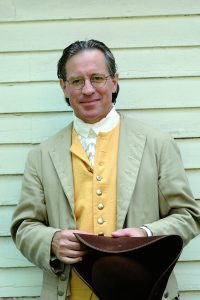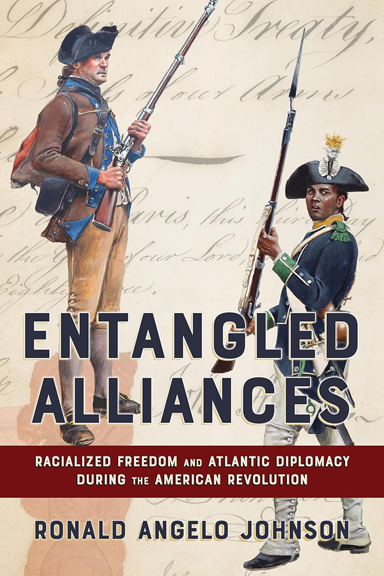Michael Dooling is an author and illustrator of educational children’s books about important periods in American History. One of his books, George Washington’s Army and Me, is being adapted for a feature film. We asked him about his work, the book, and the movie.
You’ve produced a line of children’s books and workbooks dealing with different periods in American history. Tell us a little bit about your work and your process for developing these stories.
The obscure has always piquedmy curiosity—the lesser-known but pivotal moments in history about people who changed the world: like the fossil hunter who proved that dinosaurs really once existed, the first wild and wacky horse-less carriage race, young Thomas Edison’s insatiable appetite to experiment, the bugle boy who wrote letters home to his mother, or the women and children who followed their fathers to war.
Consumed by the period you’ll find me scouring the shelves at a library, asking questions at a museum, or pestering reenactors about this and that. I’ll hold the strange and monstrous dinosaur bone, examine Edison’s gadgets, doohickeys, and thingamajigs, or putt-putt along in a horseless carriage and toot the horn, Bwonk, bwonk! Capturing the spirit of an era requires an enormous amount of research and forethought. Usually, I find much more information than I will ever need but the process is educational fun, in itself. I then spend the better part of a year or more writing, rewriting, and as my old illustrator friend used to say, pushing the paint around.
For the book George Washington’s Army and Me, I enlisted the help of the 6th Pennsylvania Regiment: a living history organization, dedicated to presenting the lives of soldiers and camp-followers serving in the American Revolutionary War. This group proved to be a valuable resource in my research and is also serving as historical advisors on the film. Some of the members even modeled for my paintings.
The Revolutionary War lasted for eight years and included many famous events. How did you decide on the specific place and time frame for your book George Washington’s Army & Me?
Nine-year-old Elijah is caught up in the midst of the revolutionary war. He, like many woman and children in 1778, followed his father, a soldier in George Washington’s army. They followed the army because they had nowhere else to go or were afraid the British army might come to their town and wreak havoc. In my research, I found The Battle of Monmouth lends itself to the storyline that I had imagined. Many soldiers died of heat exhaustion and many went missing from the battle. I inserted my character into the plot and weaved a tale of an impossible adventure that begins when Elijah sneaks out of George Washington’s encampment to find his father, a soldier who does not return from the Battle of Monmouth.
Elijah sneaks out of camp in the middle of the night and the adventure begins: he falls into a creek, encounters a frightening Indian, a mangy dog, is chased by British soldiers, has a pistol cocked just two inches from his face, and even finds himself playing draughts with General Washington.
What challenges do you face in placing a fictional story into a historically accurate context?
The facts drive the story and cannot be altered. To move from one scene to the next I imagine what could have happened in keeping with the spirit of my research. Dialogue moves the action from one scene to the next. Woven around the Battle of Monmouth is a story essentially about hope—about getting home—Elijah’s Long Journey Home.
Pa and I used to live on a farm near Philadelphia. Nine months ago, the British army came and robbed us of everything we owned. They stole our cow, chickens, and corn crop. They even smashed our furniture. They accused Pa of having sympathies for the rebels, but, honestly, he wanted no part of it. He just wanted to be a farmer. They beat him anyway. In the scuffle, my Ma was hit in the head with the butt of a musket. She held on for two days but then passed away from her injuries. We buried her in the field out back with the kind help of Reverend Toogood. I could hardly stand it. Pa was so angry we left, and he joined the 6th Pennsylvania Regiment. The last thing I can remember seeing is the sign Ma had hung on the front door of our farmhouse that read, “Home, Sweet Home.”
What resources were most useful to you in researching this story?

I rely on primary sources: military letters and diaries that explain a minutia of seemingly trivial but interesting facts that paint a picture of life in 1778. For instance, women and children had to work for rations. Even children drank beer—a kind of light beer made from the twigs of a spruce tree that according to Elijah tasted horrible. And believe me, it does, I’ve tried it. Unfortunately, if a soldier died his family had forty-eight hours to get out of camp because Washington felt that camp followers slowed down his army.
Did your own views and understanding change in the course of your research? What was your own biggest revelation or greatest discovery?
I have always been a home-body, at heart. A couple of my books deal with this topic. It is heartbreaking to imagine the struggles that people endured during the war for independence. Women and children pushed along following their loved one: sometimes walking nine miles-a-day carrying all their belongings, sleeping on the ground, and having very little to eat. It was an army of women and children struggling to keep up.
But keeping up was hard to do. We had been walking since before daybreak. Two thousand civilians marched behind the army, each one of us carrying our worldly possessions: most haversacks were full of wooden bowls, spoons, plates, pots, pans, blankets, forks, knives, tankards, and canteens; most shoulders were sore and laden with brass kettles, iron pots, well buckets, lanterns, washtubs, chairs, benches, you name it. If we couldn’t carry it, it got left behind. I suspect the road traveled was littered with fine articles that at one time, a lad or lass, could not have done without. It was a caravan of rag-tag, poorly clothed suffering individuals from all walks of life, speaking various dialects: Irish, Scotch, Dutch, English, German, and some curious lingoes I could only speculate on. There were tradesmen, as well: carpenters, blacksmiths, forgemen, coopers, smiths, wheelwrights, saddlers, wagoners, bellowmakers, rope and tent-makers, nailers, and sutlers. Malcontents, scallywags, scoundrels, and women of the lower social orders rounded out the bunch.
Tell us about the feedback you’ve gotten on this particular story and the workbook that goes with it.
George Washington’s Army and Meis a very popular book—one of my best sellers. Many teachers use this book, and the companion Literature Guide, as tools when introducing the subject of the revolutionary war. I visit many elementary schools each year and talk about how I write and illustrate and this story always touches a nerve. It is hard to fathom that someone’s life (Elijah’s) could be so difficult. So, to make the events palatable I created a character that children today can relate to: a character that plays Checkers.
Elijah’s only solace—his only piece of ‘home’ —is occasionally getting to play draughts (checkers) with his Pa.
It reminds him of home and of his mom: both of which were taken from him by the British army. Draughts was very popular during the colonial period and plays an essential role in the film. The game of Draughts is basically a character in itself. In the story, circumstances lead Elijah to even play with General Washington! I won’t spoil the ending, but let’s just say that the game of Draughts saves Elijah’s life. Most kids today have played checkers at some point in their life and can relate.
George Washington’s Army & Me is being made into a movie. How did that opportunity come about?
Andrea Clarke, the producer at 1663MediaArts, read the story and loved it. Andrea has a great sense of storytelling and could see Elijah’s character coming to life. It is a film that adults and children alike can appreciate. Filled with adventure, drama, and humor George Washington’s Army and Me is tailor-made for the big screen.
An impossible adventure begins when a young boy sneaks out of George Washington’s encampment to find his father, a soldier who does not return from the Battle of Monmouth.
Will the game of draughts save the young boy’s life and get him home?
What changes had to be made to the story in order to adapt it to a screenplay?
The original thirty-two-page picture book is only about 1,000 words and is streamlined for an elementary school audience. The film’s story had to be expanded ten-fold: lengthening scenes, adding new scenes, and introducing new characters. Each character was developed and obscure but important facts were added that just don’t quite fit into the picture book. The film goes deeper into the lives of eighteenth-century people.
In your view, what are the most important aspects of the American Revolution that children should understand?
The men, women, and children that struggled and fought for freedom paved the way for our way of life. Home, Sweet Home.
What else would you like readers to know about your books, the movie, or about this time period?
History is fascinating and can be fun. Read the Book. Watch the Film’s Trailer. PLAY Draughts like Elijah!
Like Benjamin Franklin said, “For life is a kind of Draughts, in which we have points to gain and competitors or adversaries to contend with…”








2 Comments
I love the image that accompanies this article. Is this a still from the movie? Or is it an illustration by Michael Dooling based on the movie? Thanks!
Good morning, Katie,
This is a composite of two of the illustrations that I painted (oil on canvas) for the picture book, George Washington’s Army and Me. See the original illustrations here:
http://www.michaeldooling.com/gallery.html
Thank you for your kind words. Mike